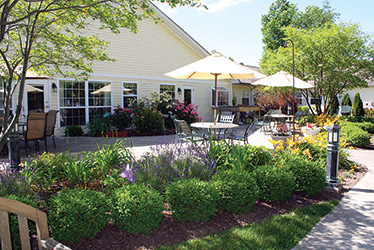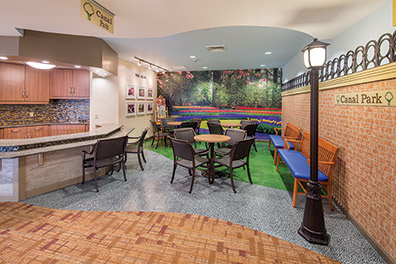
In 1994, President Ronald Reagan penned a letter announcing to the American public that he had Alzheimer’s disease. Having a prominent statesman admit his battle with Alzheimer’s put the discussion of caring for people with memory care into the public eye. Up until that point, the 4 million Americans living with Alzheimer’s, most aged 65 and older, had very few care options other than nursing facilities and hospitals.
Today, there are 5.8 million people in the U.S. living with Alzheimer’s and other related dementias, with another person diagnosed with the disease every 65 seconds. As baby boomers reach retirement, memory care has again returned to the forefront of discussion.
Long term and post-acute care organizations are now offering a spectrum of services for patients living with memory loss who require long term care. Twenty-five years ago, HCR ManorCare was one of the first providers to address care settings to offer quality care in an engaging and social environment by creating Arden Courts Memory Care Communities.
At the Beginning
The first Arden Courts Memory Care Community was built in 1994 in Potomac, Md. Five years of research and planning by dementia experts went into developing an assisted living environment that would help people living with Alzheimer’s maximize their sense of independence and increase their self-esteem by utilizing their cognitive abilities in a safe and secure environment. “Arden Courts set out to specifically design an environment that could provide a living option for persons living with Alzheimer’s disease and related forms of dementia to receive the unique care needed without sacrificing their quality of life,” says Mark McBride, vice president and general manager of Arden Courts.
Since building that first location in 1994, Arden Courts has opened 52 memory care communities located in 11 states. Originally designed for a resident population comprised of persons living in the early to middle stages of dementia, Arden Courts has adapted dementia caregiving techniques for all stages of Alzheimer’s, Parkinson’s disease, Lewy body dementia, frontotemporal degeneration, and early-onset and other forms of dementia.
Arden Courts now has increased its clinical staff and its number and types of programming, as well as changed the food and dining protocol to maximize self-function and independence for residents.
Experience Makes a Difference
“Our 25 years of experience caring for over 43,500 residents not only has improved and transformed the way Arden Courts delivers care, but has also evolved how the community is designed in order to better meet the changing needs of the resident population,” says Pauline Coram, director of executive learning for Arden Courts.
“Arden Courts was among the first standalone, purposefully built memory care communities to feature a ‘house’ design that evokes a sense of home,” she says.
Each house has a living room, laundry, kitchen, and dining room. In addition, doors lead to an enclosed, protected outdoor courtyard with garden areas and landscaped walking paths and sitting areas.
The four houses at Arden Courts were designed in a homelike manner. Initially, the houses were planned as four separate living quarters, each with a porch, front door, mailbox, door knocker, foyer, and hallway leading to the common areas and bedrooms, Coram says.
“Arden Courts found its residents enjoyed exploring and purposeful wandering, so the front doors of the houses were left open to the communal areas, and residents could visit the social gathering places, such as the studio, health center, beauty salon, and shop windows, or simply sit on one of the porches for awhile,” she says. “This area also had additional access to the secured outdoor areas with guided
pathways, gardens, and foliage.”
The organization also retrofitted some living rooms in the houses to be able to conduct Namaste Care™ for individuals with advanced dementia. The Namaste program focuses on persons living in the latter stages of dementia with a “loving touch” in an environment that nurtures and stimulates the senses. The environment is carefully created with scents of lavender, soft music, nature scenes, hydration, and nurturing appealing to the senses of smell, touch, taste, hearing, and vision.
The soothing, slower-paced environment can help reduce agitation and anxiety in persons living with dementia by providing respite for the resident. Namaste also creates opportunities to increase hydration, which can help avoid dehydration issues and infections. Arden Courts was the first national assisted living company to embrace Namaste Care in its communities.
Living Spaces Evolve, Indoors and Out
A staple for the design of Arden Courts is the courtyard, which has been beneficial physically and emotionally for the residents. Courtyards are designed with meandering paths, garden areas, and outdoor birdbaths and water features to encourage residents to explore and be involved with nature. It also provides an opportunity to exercise, while keeping residents safe.
Additionally, certain aspects of the outdoor area have been redesigned to serve more as destination opportunities, such as the installation of sitting areas and gazebos, places where families are able to interact and relax with their loved ones. The added elements of design such as gardening areas, bird-feeding stations, and flower beds also encourage the resident to explore, engage, and be involved with nature.
Connecting each of the four houses, Arden Courts features a core area that contains an art studio, porches, community center, health center, and a beauty/barber salon. Originally designed with the resident in mind, it quickly became obvious that this area is a great location where families can gather. “The core design has also evolved by enhancing the porches and common areas into destinations where families would mingle with their loved ones,” says Coram. Renovations included opening up the space between the community center and studio, which was originally designed as two separate rooms.
“Before the two spaces were separated, programming personnel recommended joining the spaces for two reasons: to create a larger common area that allowed for more programming flexibility with family and themed events, and to provide an opportunity for residents to stay together with purposeful environmental movement and structured programming throughout the day,” Coram says.
Practical changes have also been necessary. Replacement finishes and furniture in the houses and the core areas were adjusted to accommodate the ever-changing needs of residents, while maintaining the residential focus of Arden Courts.
Design Based on Visual Cueing
Arden Courts management knew from their original research that visual cueing is critical for persons living with dementia. Multiple and varied prompts are offered throughout the residence to help define the spaces and provide residents way-finding success, which encourages a sense of control and purpose. Each house has always featured a different color scheme and theme, as well as memory boxes outside each resident room containing personal photos and mementos to help residents recognize their house and own rooms. A name plate and bedroom room number serve as additional cueing prompts.

Even in the common areas, signage offers both pictures and words, including the beauty/barber salon signage that features a picture of a brush and scissors and the art studio’s picture of a paintbrush with a palette.
“As times have changed, so has the color palette at Arden Courts to correspond with current design trends,” says Coram. “In addition to aesthetic updates, more signage was created in common areas to offer simple instructions for residents to increase engagement with their environment, both indoors and outdoors.”
Signs have been added to common areas engaging residents to comment on colors of flowers located in the garden area. Inside, signs encourage residents to help sort linens and ask them to comment on the different scenes within artwork on the walls. “Intended to be self-starters, these guided requests encourage the resident to read and partake in activities. Accomplishing these activities leads to increased engagement and self-esteem,” says Coram.
The Future and Changing Demographics
When originally designed in 1994, Arden Courts worked primarily with the spouse of the resident. This has changed. As people with dementia stay home longer and come to Arden Courts reflecting differing dementias and the varying phases of the disease process, adult children now share in the decision process.
“The many health discoveries in care delivery, research, and medications have changed the way we view the world of dementia, and they are influencing the changes of the future,” says McBride.
“Despite all the change, Arden Courts continues to offer families the peace of mind they deserve, knowing their loved ones are being cared for by experienced people and in a proven environment, which is continuously evolving.”